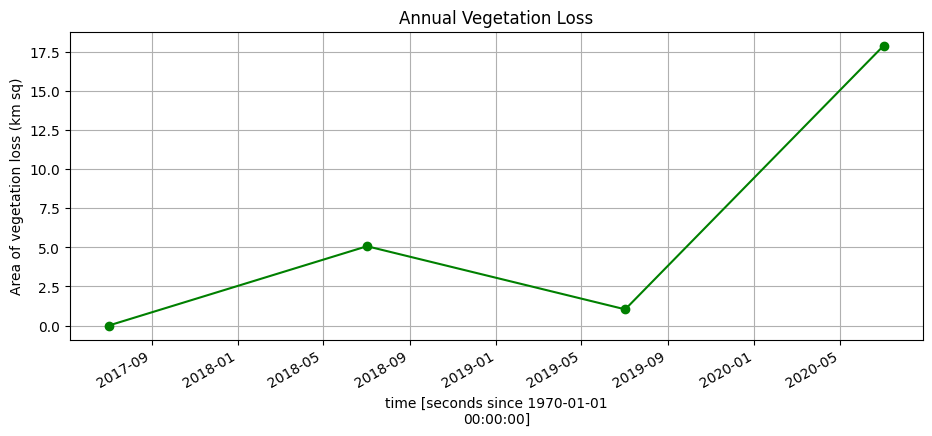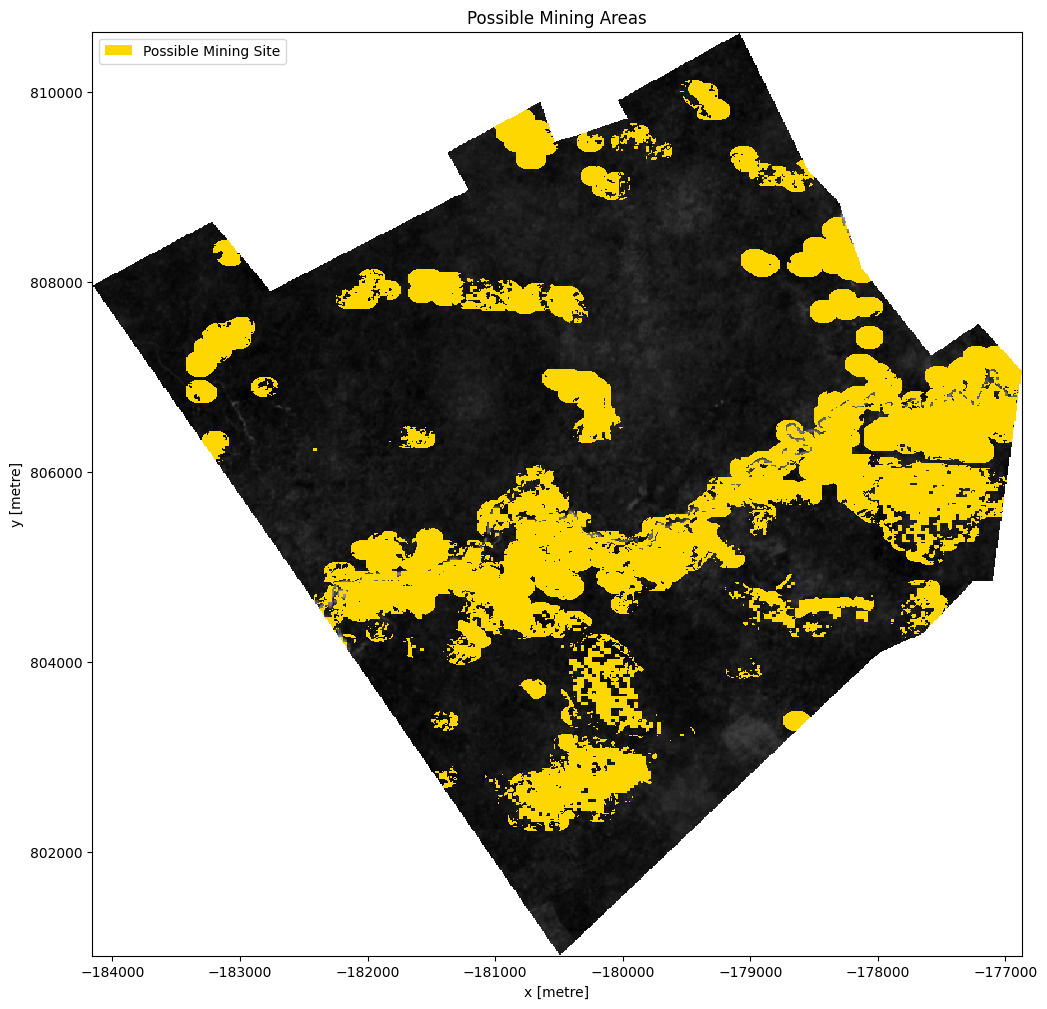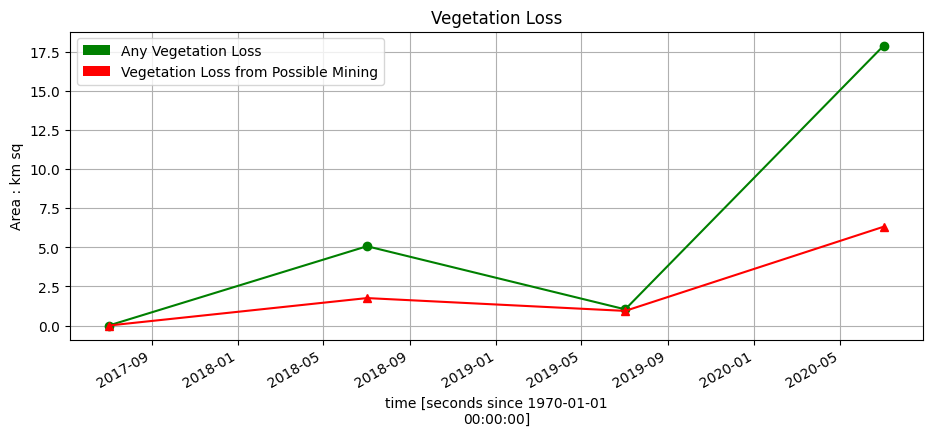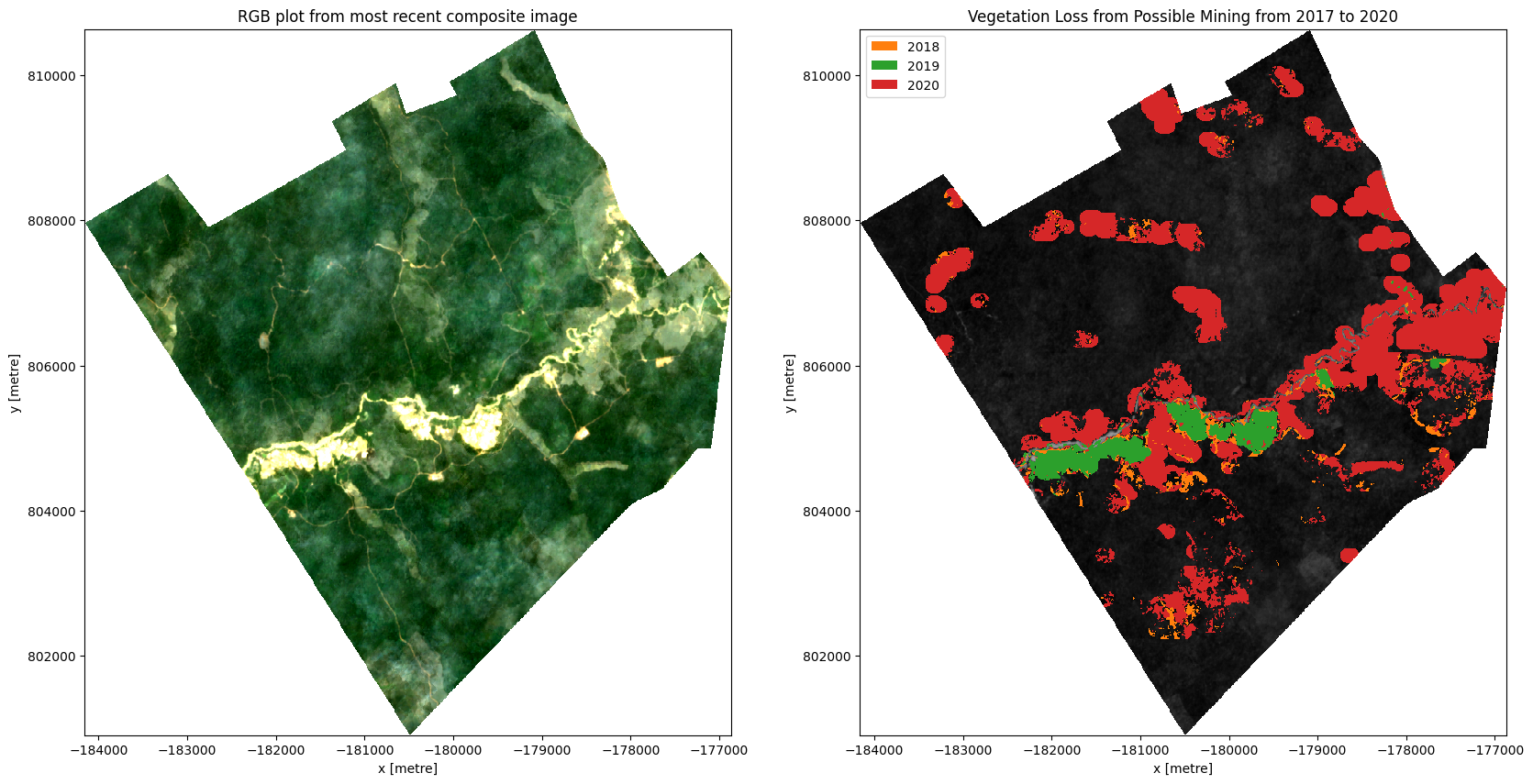Surface Mining Screening¶
Products used: gm_s2_annual, s1_rtc, wofs_ls_summary_annual
Keywords: data used; sentinel-2 geomedian, data used; WOfS, analysis; change monitoring, use case; surface mining, data used; sentinel-1
Background¶
Surface mining refers to the removal of the terrain surface to access minerals underneath. In particular, surface mining is used to retrieve sand, gravel, stones, coal, iron and other metals. Surface mining is often more cost-effective than gouging tunnels and subterranean shafts to access minerals underground.
Although surface mining contributes to the source of income for a country, these operations can result in deleterious impacts on farmlands, forests, and water bodies. Government officials are making efforts to identify areas of these mining activities.
This notebook demonstrates a method for identifying areas of surface mining activity. The notebook combines methods based on vegetation loss and water detection. Although the notebook aids in detecting these areas, further verification by government agencies or institutions are required to validate the operations on the ground.
Description¶
Surface mining operations often result in the clearing of vegetation and the development of water from the land. Using remote sensing images from Sentinel-2 GEOMAD or Sentinel-1, and DE Africa’s Water Observations from Space (WOfS) product, this notebook screen areas where there is a possibility of surface mining.
The notebook uses Normalised Difference Vegetation Index (for sentinel-2) or the Radar Vegetation Index (for sentinel-1) to determine vegetation loss, where loss occurs if the change in vegetation index is negative. DE Africa’s WOfS product is used to identify water.
The final product identifies pixels that exhibit vegetation loss, and the presence of water. In most cases, these algorithms can be used to identify clusters of pixels that have experienced change and allow targeted investigation of those areas by local or regional governments.
The notebook demonstrates how to:
Load data for a given location and time period
Calculate the vegetation change
Calculate the presence of water
Combine vegetation change and water extent change into one plot to show possible mining areas
Getting started¶
Load packages¶
[1]:
# Import functions for this notebook
from Surface_mining_screening import (
calculate_area_per_pixel,
load_vector_file,
process_data,
calculate_vegetation_loss,
plot_possible_mining,
plot_vegetationloss_mining,
)
Analysis parameters¶
The following cell sets the parameters, which define the area of interest and the length of time to conduct the analysis over. The area of interest must be defined with a shapefile (.shp), a geojosn (.geojson), or a KML file (.kml).
The parameters are:
start_year: The year to start the analysisend_year: The year to end the analysisproduct: whether oto use Sentinel-2 or sentinel-1 for the analysis, acceptable values are's2'or's1'threhold: The threshold to use for indentifying vegetaton loss, this can either be a float e.g.-0.15, or'otsu', in which case the threshold will be automatically identified using the otsu method.vector_file: The file path and name of a vector file containing the extent. Can be a.kmlfile, or a.shpfile.
If running the notebook for the first time, keep the default settings below. This will demonstrate how the analysis works and provide meaningful results. The example covers part of the Essen Apam Forest Reserve, Ghana, and uses the shapefile provided in Supplementary Data.
[2]:
start_year = 2017
end_year = 2020
product= 's2'
threshold = -0.1
vector_file = "./data/Apam_forest.shp"
View the area of interest defined by the vector file¶
[3]:
gdf, geom = load_vector_file(vector_file)
Load and process data¶
This analysis uses two datasets:
Sentinel-2 geomedians or Sentinel-1 backscatter for identifying vegetation loss
Water Observations from Space (WOfS) for identifying water
If an area has experienced both vegetation loss and water presence, it may be related to surface mining activity.
The function below loads Sentinel-2 or sentinel-1 and WOfS for the area of interest and does a number of cleaning and processing steps. The function will also plot an RGB image for each year in the analysis
Note, if the product used is Sentinel-1, this cell can take a few minutes to run as annual medians are calculated on-the-fly
[4]:
sentinel, wofs = process_data(gdf, geom, start_year, end_year, product=product)
/usr/local/lib/python3.10/dist-packages/matplotlib/cm.py:478: RuntimeWarning: invalid value encountered in cast
xx = (xx * 255).astype(np.uint8)

Calculate vegetation loss¶
The next function determines whether NDVI (or RVI) decreased between one year and the next. If so, the area experienced vegetation loss. Significant vegetation loss is determined using the threshold defined in Analysis Parameters. You may want to tune this threshold to better delineate the areas experiencing vegetation loss.
The function returns the annual vegetation loss (in square kilometres) and the total vegetation loss over all years of the analysis. It then plots the annual vegetation loss.
[5]:
veg_loss_annual, veg_loss_all = calculate_vegetation_loss(sentinel, threshold=threshold, product=product)

Determine possible mining areas¶
When water (WOfS) and vegetation loss are coincident, the area is classified as high-potential mining site.
Areas within 250 metres of a high-potential mining site where there was only vegetation loss are also considered to be possible mining sites.
[6]:
vegetation_loss_mining = plot_possible_mining(sentinel, veg_loss_all, wofs, product=product)

Examine vegetation loss from possible mining each year¶
The final function compares the vegetation loss from possible mining to all vegetation loss each year, and builds a spatial plot showing the vegetation loss from possible mining each year.
[7]:
plot_vegetationloss_mining(sentinel, veg_loss_annual, vegetation_loss_mining, product=product)
Total Area(kmsq) of the vector file 36.2628
...................................................................
2017 2018 2019 \
Any Vegetation Loss(kmsq) 0.0 5.065500 1.032800
Any Vegetation Loss(%) 0.0 13.968861 2.848098
Vegetation Loss from Possible Mining(kmsq) 0.0 1.753300 0.933700
Vegetation Loss from Possible Mining(%) 0.0 4.834982 2.574815
2020
Any Vegetation Loss(kmsq) 17.886900
Any Vegetation Loss(%) 49.325755
Vegetation Loss from Possible Mining(kmsq) 6.315000
Vegetation Loss from Possible Mining(%) 17.414541
...................................................................
<Figure size 1200x1200 with 0 Axes>

...................................................................
/usr/local/lib/python3.10/dist-packages/matplotlib/cm.py:478: RuntimeWarning: invalid value encountered in cast
xx = (xx * 255).astype(np.uint8)

Additional information¶
License: The code in this notebook is licensed under the Apache License, Version 2.0. Digital Earth Africa data is licensed under the Creative Commons by Attribution 4.0 license.
Contact: If you need assistance, please post a question on the Open Data Cube Slack channel or on the GIS Stack Exchange using the open-data-cube tag (you can view previously asked questions here). If you would like to report an issue with this notebook, you can file one on
Github.
Compatible datacube version:
[8]:
import datacube
print(datacube.__version__)
1.8.15
Last Tested:
[9]:
from datetime import datetime
datetime.today().strftime('%Y-%m-%d')
[9]:
'2023-08-21'